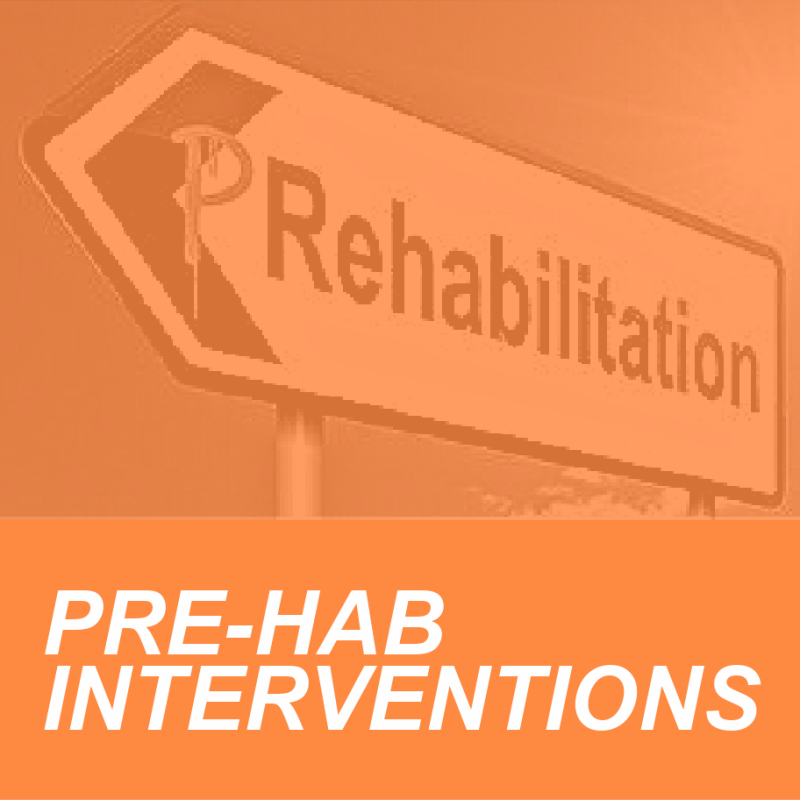
Pre-hab is becoming more of a fitness buzzword as the worlds of physical therapy and personal training collide. We understand that rehabilitation is the process of returning to a healthy and functional physical state from an injured or unhealthy one. Pre-hab, on the other hand, is the attempt to prevent injury in the first place by ensuring that mobility, stability, flexibility, and strength are equally addressed and c0-existing in harmonious balance.
Professional trainers should be aware of two key intervention factors when a client’s Pre-habilitation and Rehabilitation efforts or concerns arise:
- Prospects for a personal trainer to work with a Pre-habilitation or Rehab client are fairly high.
- The number of specialty surgical procedures is growing faster than the USA’s annual population growth.
As one (1) data point for the magnitude of pre-habilitation and re-hab regimens, about ten percent of Americans aged 65 or higher undergo surgery every year.
Key Differences
Consideration should be taken when selecting approaches for pre-hab and rehab, and understanding their distinction. Certainly, we should aim to employ techniques that mitigate stress and promote a client’s quality of life.
-
Habilitate literally means: “to equip, make fit, or capable.”
Depending on the specific nature of a client’s interest, desire, or need for habilitation, a trainer may singly or in combination:
a. help the client offset her or his expected de-conditioning in stamina or strength parameters
b. listen to, and posture to support a client’s dietary and lifestyle changes, such as smoking cessation or moderated drinking of alcohol
c. serve as a good listener and wellness advocate to help the client establish a “race plan” for what, in some cases, seems like a marathon.

2. Pre-hab Interventions
Trainers may face either or both of these “pre”- interventions for a client:
That adage about an ounce of prevention is more valuable than a pound of cure is relevant. These questions serve as a generic pre-habilitation checkout:
- Does a client’s posture or exercise form suggest a need for corrective exercises?
- Is a client’s warm-up and dynamic stretching appropriate for a specific workout and periodization?
- Has a client experienced and shared evolving aches or pains that could become chronic, if not buffered?
- Has a client’s “‘psychosocial” situation changed? Remember that there is no pain without brain.
b. Whole-body and mind “buffers”1 before invasive medical or physical procedures.
We professionals should be ready to intervene during and after stressful events that can trigger a client’s decline in physical and/or mental functions. We can be enablers for “health optimizing” behaviors of our clients. As one professional team2 offered, it is very good for a client to “Have Process Awareness before the Knife.”
3. Rehabilitation
Trainers should be prepared, if requested, to address a client’s impairments that result from treatment. One prominent “rehab” goal is to help a client resume her or his activities of daily life (ADL) without compromise. Our awareness of episodic or enduring symptoms can abet a client’s recovery and resumed “ADLs.”
Major invasive surgery has unfortunate likelihoods of post-operative complications and dampened quality of life. Minor elective surgery or chronic joint pain present lesser, yet still significant issues for us professionals to situationally address.
A qualified exercise professional might possibly help a client prevent certain elective procedures or can help with response interventions before and after a procedure or injury is deemed necessary.
- Cancer and Osteopathic surgical procedures often come to mind if a pre-habilitation or rehabilitation concern is raised.
As invasive surgery for cancer or orthopedic procedures involves the catabolic breakdown of tissue and higher oxygen needs, a client’s anxiety and stress must be a habilitative factor to address or overcome. Indirect support or direct efforts by a professional trainer for surgical rehabilitation may possibly reduce the client’s odds for post-procedure complications.
Yet, eye surgeries and general internal procedures also have high age-dependent incidences in our adult population. “Wear and tear” conditions, ranging from shin splints or plantar fasciitis to osteoarthritic joints to tennis or rower’s elbows may also lead t0 a client’s request for counsel about habilitation.
If one takes a broad definition of therapeutic intervention, it extends beyond surgeries for the physical or medical conditions of a client.
This author was told by an orthopedic surgeon about his rotator cuff injury,
“the best time to choose elective surgery is when you can’t not have surgery.”
(I was thankfully able to avoid shoulder surgery with a planned pre-habilitation regimen of stretching and tailored resistance work.)
Summary
Getting sidelined by a medical or physical condition is not fun for either a client or a professional trainer. Yet, when the sideline signal arises, situational and prudent actions by a trainer can help a client return to action.
Prudent “pre-hab” interventions may situationally avert surgical or extended therapeutic “cures.” Counteracting a client’s natural misalignment or weaknesses is a worthy pre-habilitation goal for ADL.
If a client experiences a chronic physical stressor or is diagnosed with the need for corrective surgery, a trainer should be equipped to intervene on a client’s behalf to assist in recovery efforts for resumed ADL.
References
1) BMJ 2017; 358:j3702
2)Perioper Med (Lond). 2017 Jun 20;6:9.





